The Preparation of High Saturation Magnetization and Low Coercivity Feco Soft Magnetic Thin Films via Controlling the Thickness and Deposition Temperature
Abstract
1. Introduction
2. Experimental
3. Results and Discussion
4. Conclusions
Author Contributions
Funding
Institutional Review Board Statement
Informed Consent Statement
Data Availability Statement
Conflicts of Interest
References
- Zhou, Y.; Kou, X.M.; Mu, M.K.; McLaughlin, B.M.; Chen, X.; Parsons, P.E.; Zhu, H.; Ji, A.; Lee, F.C.; Xiao, J.Q. Loss characterization of Mo-doped FeNi flake for DC-to-DC converter and MHz frequency applications. J. Appl. Phys. 2012, 111, 07E329. [Google Scholar] [CrossRef]
- Nakano, T.; Nepal, B.; Tanaka, Y.; Wu, S.; Abe, K.; Mankey, G.; Mewes, T.; Mewes, C.; Suzuki, T. Soft magnetic and structural properties of (FeCo)-(AlSi) alloy thin films. J. Magn. Magn. Mater. 2020, 507, 166852. [Google Scholar] [CrossRef]
- Li, T.; Liu, X.; Li, J.; Pan, L.; He, A.; Dong, Y. Microstructure and magnetic properties of FeCoHfN thin films deposited by DC reactive sputtering. J. Magn. Magn. Mater. 2022, 547, 168777. [Google Scholar] [CrossRef]
- Snoek, J.L. Dispersion and Absorption in Magnetic Ferrites at Frequencies Above one MC/S. Physica 1948, 14, 207–217. [Google Scholar] [CrossRef]
- Sundar, R.S.; Deevi, S.C. Soft magnetic FeCo alloys: Alloy development, processing, and properties. Int. Mater. Rev. 2005, 50, 157–192. [Google Scholar] [CrossRef]
- Najafi, A.; Nematipour, K. Synthesis and Magnetic Properties Evaluation of Monosized FeCo Alloy Nanoparticles through Microemulsion Method. J. Supercond. Nov. Magn. 2017, 30, 2647–2653. [Google Scholar] [CrossRef]
- Acher, O.; Adenot, A.L. Bounds on the dynamic properties of magnetic materials. Phys. Rev. B 2000, 62, 11324–11327. [Google Scholar] [CrossRef]
- Ludwig, A.; Frommberger, M.; Zanke, C.; Glasmachers, S.; Quandt, E. Magnetoelastic thin films and multilayers for high-frequency applications. In Proceedings of the Smart Structures and Materials 2002 Conference, San Diego, CA, USA, 18–21 March 2002; pp. 542–552. [Google Scholar]
- Yuan, B.B.; Liu, X.L.; Wang, L.S.; Peng, D.L.; Wei, J.W.; Wang, J.B. Magnetic properties of FeCo-O/NiZn-Ferriten bi-magnetic phase nanocomposite multilayer films. In Proceedings of the 7th IEEE International Nanoelectronics Conference (IEEE INEC), Chengdu, China, 7–11 May 2016. [Google Scholar]
- Wang, Y.; Wang, L.; Zhang, H.; Zhong, Z.; Peng, D.; Ye, F.; Bai, F. Investigation of FeCo-Ti-O nanogranular films with tunable permeability spectrum. J. Alloys Compd. 2016, 667, 229–234. [Google Scholar] [CrossRef]
- Hao, G.; Zhang, D.; Jin, L.; Zhang, H.; Tang, X. Nanogranular CoFe-yttrium-doped zirconia films for noise suppressor. In Proceedings of the 2015 IEEE International Magnetics Conference (INTERMAG), Beijing, China, 11–15 May 2015; p. 1. [Google Scholar] [CrossRef]
- Bozorth, R.M. Ferromagnetism; IEEE: New York, NY, USA, 1993. [Google Scholar]
- Wu, Y.P.; Han, G.-C.; Kong, L.B. Microstructure and microwave permeability of FeCo thin films with Co underlayer. J. Magn. Magn. Mater. 2010, 322, 3223–3226. [Google Scholar] [CrossRef]
- Liu, M.; Shi, L.; Lu, M.; Xu, S.; Wang, L.; Li, H. Enhanced (200) Orientation in FeCo/SiO2 Nanocomposite Films by Sol-Gel Spin-Coating on Al Underlayer. J. Supercond. Nov. Magn. 2016, 29, 835–838. [Google Scholar] [CrossRef]
- Akansel, S.; Venugopal, V.A.; Kumar, A.; Gupta, R.; Brucas, R.; George, S.; Neagu, A.; Tai, C.W.; Gubbins, M.; Andersson, G.; et al. Effect of seed layers on dynamic and static magnetic properties of Fe65Co35 thin films. J. Phys. D-Appl. Phys. 2018, 51, 305001. [Google Scholar] [CrossRef]
- Liu, X.; Kanda, H.; Morisako, A. The effect of underlayers on FeCo thin films. In Proceedings of the 2nd International Symposium on Advanced Magnetic Materials and Applications (ISAMMA), Sendai, Japan, 12–16 July 2010. [Google Scholar]
- Liu, X.-L.; Wang, L.-S.; Luo, Q.; Xu, L.; Yuan, B.-B.; Peng, D.-L. Preparation and high-frequency soft magnetic property of FeCo-based thin films. Rare Met. 2016, 35, 742–746. [Google Scholar] [CrossRef]
- Xu, F.; Xu, Z.; Yin, Y. Tuning of the Microwave Magnetization Dynamics in Dy-Doped Fe65Co35-Based Thin Films. IEEE Trans. Magn. 2015, 51, 2800904. [Google Scholar] [CrossRef]
- Liu, M.; Hu, L.; Ma, Y.; Feng, M.; Xu, S.; Li, H. Effect of Pt doping on the preferred orientation enhancement in FeCo/SiO2 nanocomposite films. Sci. Rep. 2019, 9, 10670. [Google Scholar] [CrossRef]
- Basumatary, H.; Chelyane, J.A.; Rao, D.V.S.; Kamat, S.V.; Ranjan, R. Influence of substrate temperature on structure, microstructure and magnetic properties of sputtered Fe-Ga thin films. J. Magn. Magn. Mater. 2015, 384, 58–63. [Google Scholar] [CrossRef]
- Wei, Y.; Brucas, R.; Gunnarsson, K.; Harward, I.; Celinski, Z.; Svedlindh, P. Static and dynamic magnetic properties of bcc Fe49Co49V2 thin films on Si(100) substrates. J. Phys. D-Appl. Phys. 2013, 46, 495002. [Google Scholar] [CrossRef]
- Umadevi, K.; Chelvane, J.A.; Jayalakshmi, V. Magnetostriction and Magnetic Microscopy Studies in Fe-Co-Si-B Thin Films. Mater. Res. Express 2018, 5, 036102. [Google Scholar] [CrossRef]
- Wang, C.; Xiao, X.; Rong, Y.; Hsu, T.Y. The effect of substrate temperature on the microstructure and tunnelling magnetoresistance of FeCo-Al2O3 nanogranular films. J. Mater. Sci. 2006, 41, 3873–3879. [Google Scholar] [CrossRef]
- Abe, K.; Wu, S.; Tanaka, Y.; Ariake, Y.; Kanada, I.; Mewes, T.; Mankey, G.; Mewes, C.; Suzuki, T. The thickness and growth temperature dependences of soft magnetic properties and an effective damping parameter of (FeCo)-Si alloy thin films. AIP Adv. 2019, 9, 035139. [Google Scholar] [CrossRef]
- Kumari, T.P.; Raja, M.M.; Kumar, A.; Srinath, S.; Kamat, S.V. Effect of thickness on structure, microstructure, residual stress and soft magnetic properties of DC sputtered Fe65Co35 soft magnetic thin films. J. Magn. Magn. Mater. 2014, 365, 93–99. [Google Scholar] [CrossRef]
- Fu, Y.; Cheng, X.; Yang, Z. Magnetically soft and high-saturation-magnetization FeCo films fabricated by co-sputtering. Phys. Status Solidi A-Appl. Mater. Sci. 2005, 202, 1150–1154. [Google Scholar] [CrossRef]
- Platt, C.L.; Berkowitz, A.E.; Smith, D.J.; McCartney, M.R. Correlation of coercivity and microstructure of thin CoFe films. J. Appl. Phys. 2000, 88, 2058–2062. [Google Scholar] [CrossRef]
- Li, Y.; Li, Z.; Liu, X.; Fu, Y.; Wei, F.; Kamzin, A.S.; Wei, D. Investigation of microstructure and soft magnetic properties of Fe65Co35 thin films deposited on different underlayers. J. Appl. Phys. 2010, 107, 09A325. [Google Scholar] [CrossRef]
- Liu, S.Y.; Cao, Q.P.; Mori, S.; Ishigami, K.; Igarashi, K.; Wang, C.; Qian, X.; Wang, X.D.; Zhang, D.X.; Riedmuller, B.; et al. Synthesis and magnetic properties of amorphous Fe-Y-B thin films. J. Alloys Compd. 2014, 606, 196–203. [Google Scholar] [CrossRef]

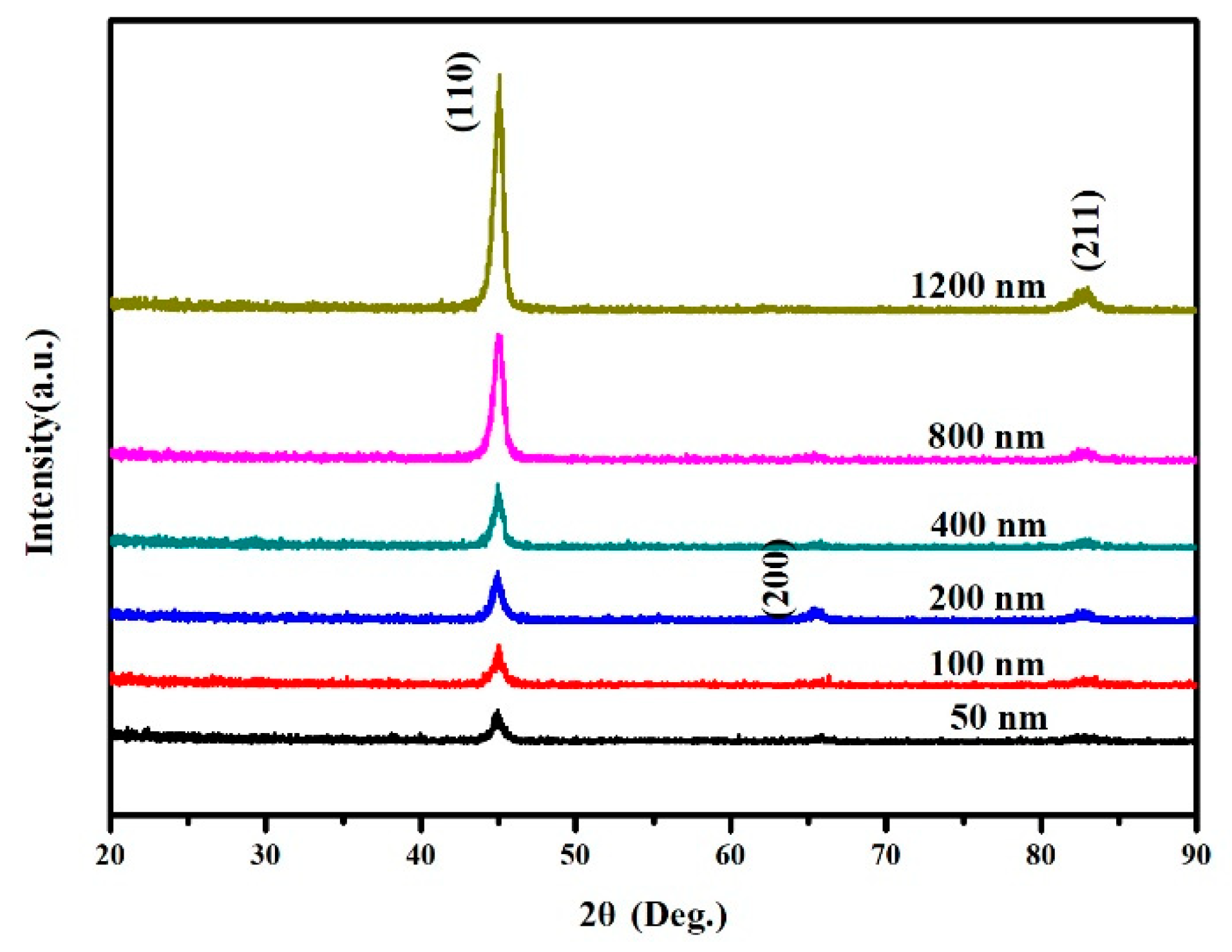

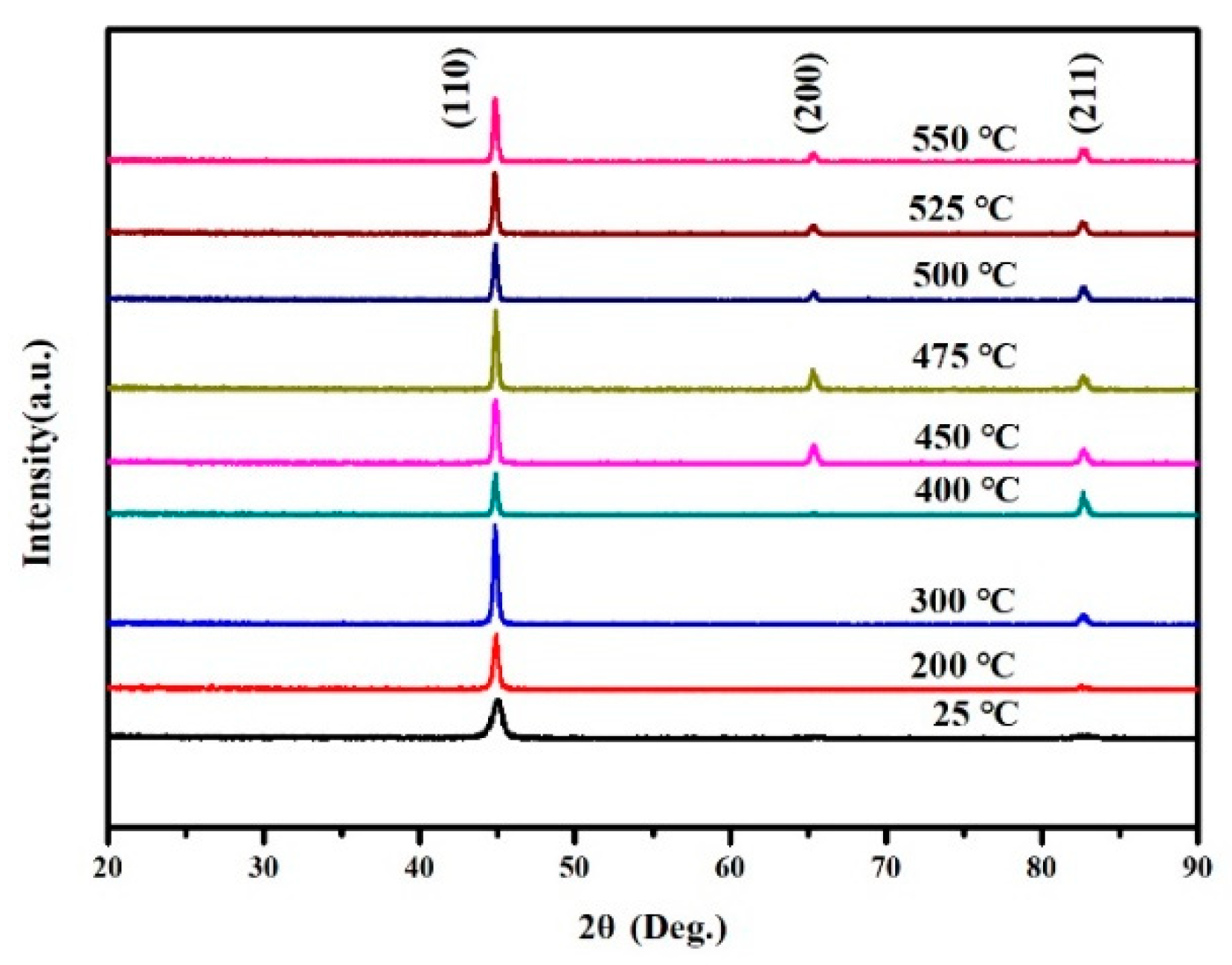


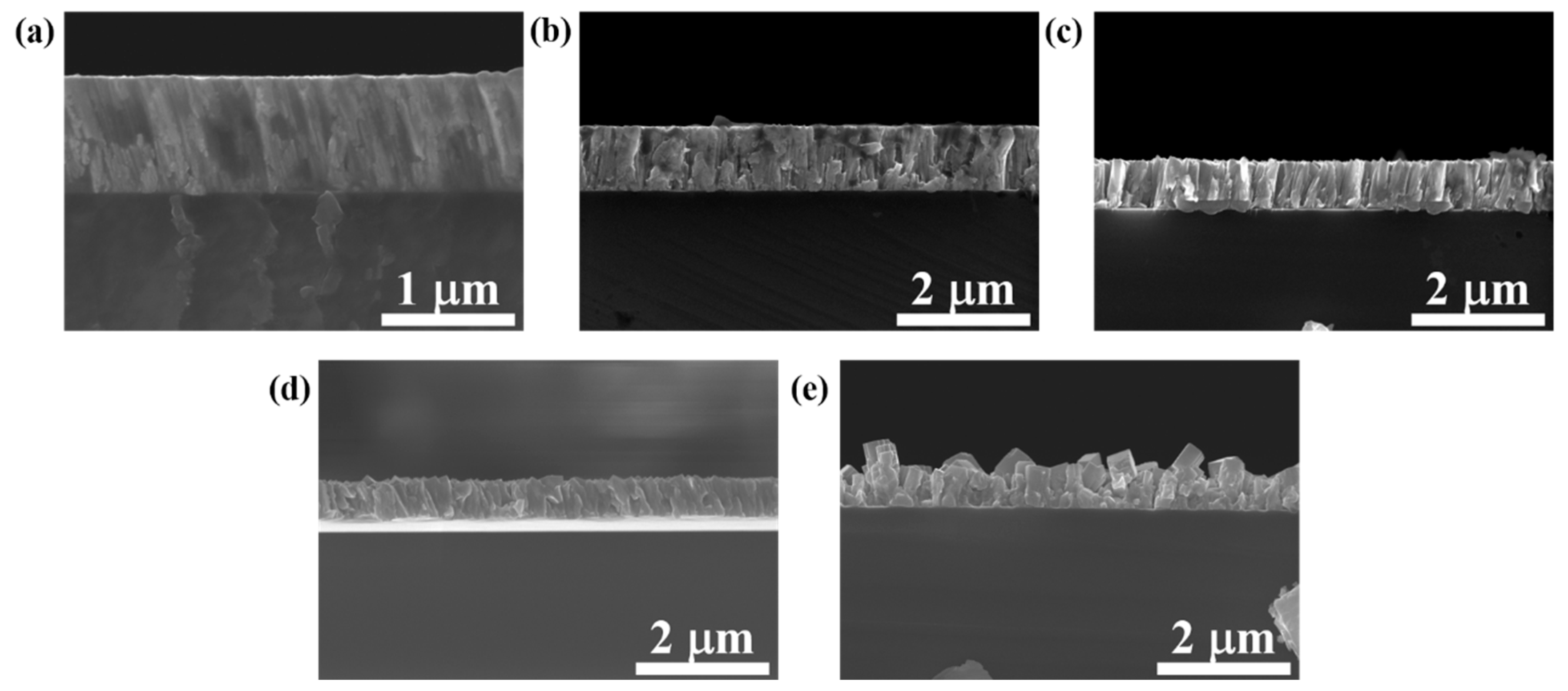

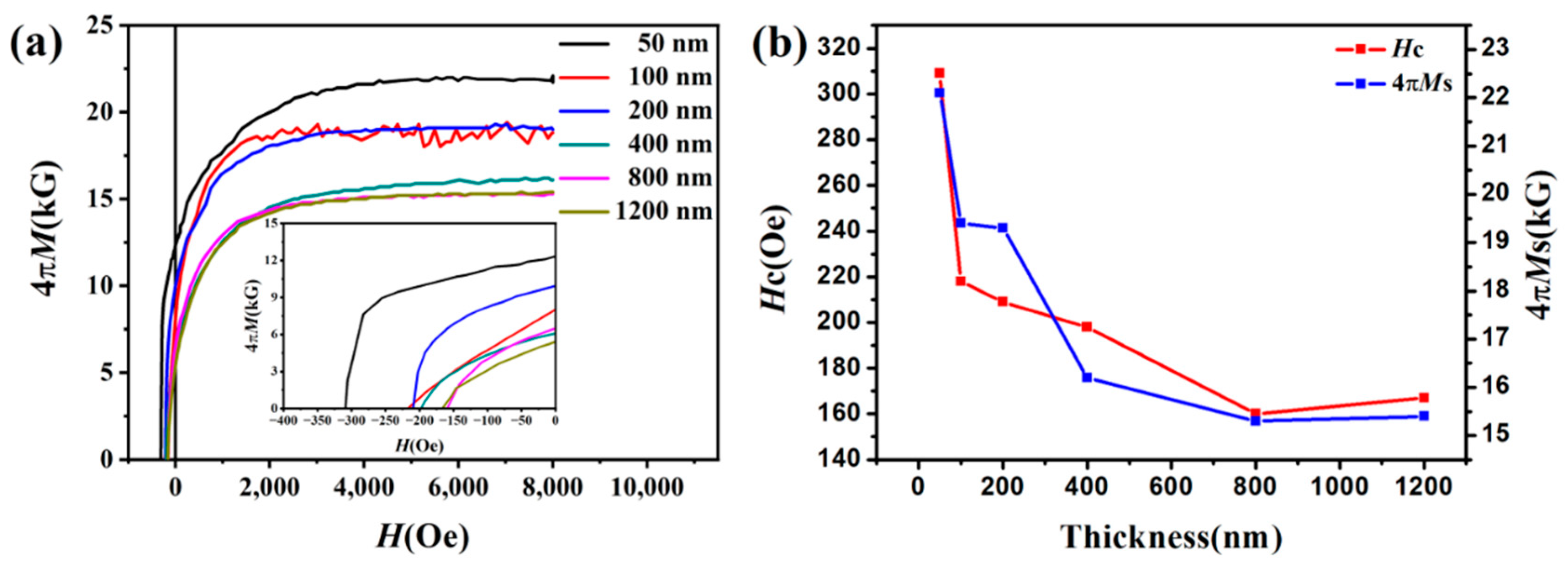

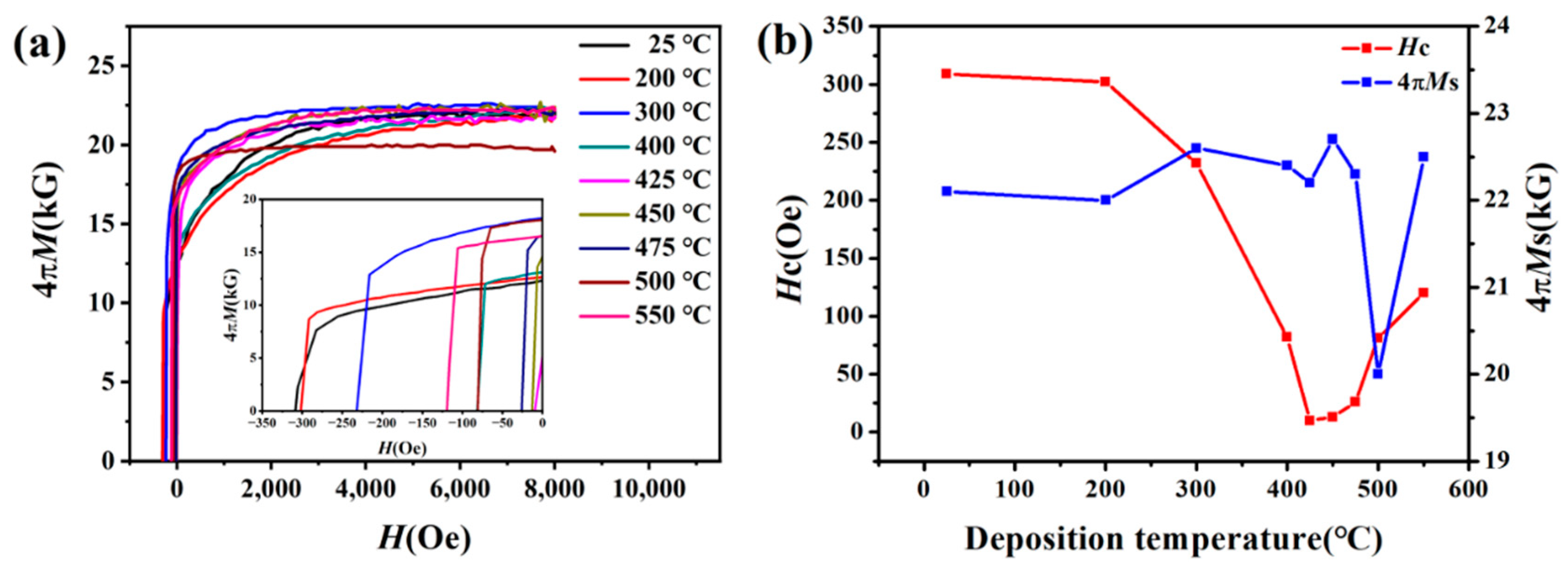
Publisher’s Note: MDPI stays neutral with regard to jurisdictional claims in published maps and institutional affiliations. |
© 2022 by the authors. Licensee MDPI, Basel, Switzerland. This article is an open access article distributed under the terms and conditions of the Creative Commons Attribution (CC BY) license (https://creativecommons.org/licenses/by/4.0/).
Share and Cite
Yang, W.; Liu, J.; Yu, X.; Wang, G.; Zheng, Z.; Guo, J.; Chen, D.; Qiu, Z.; Zeng, D. The Preparation of High Saturation Magnetization and Low Coercivity Feco Soft Magnetic Thin Films via Controlling the Thickness and Deposition Temperature. Materials 2022, 15, 7191. https://doi.org/10.3390/ma15207191
Yang W, Liu J, Yu X, Wang G, Zheng Z, Guo J, Chen D, Qiu Z, Zeng D. The Preparation of High Saturation Magnetization and Low Coercivity Feco Soft Magnetic Thin Films via Controlling the Thickness and Deposition Temperature. Materials. 2022; 15(20):7191. https://doi.org/10.3390/ma15207191
Chicago/Turabian StyleYang, Wenjie, Junjie Liu, Xiangfeng Yu, Gang Wang, Zhigang Zheng, Jianping Guo, Deyang Chen, Zhaoguo Qiu, and Dechang Zeng. 2022. "The Preparation of High Saturation Magnetization and Low Coercivity Feco Soft Magnetic Thin Films via Controlling the Thickness and Deposition Temperature" Materials 15, no. 20: 7191. https://doi.org/10.3390/ma15207191
APA StyleYang, W., Liu, J., Yu, X., Wang, G., Zheng, Z., Guo, J., Chen, D., Qiu, Z., & Zeng, D. (2022). The Preparation of High Saturation Magnetization and Low Coercivity Feco Soft Magnetic Thin Films via Controlling the Thickness and Deposition Temperature. Materials, 15(20), 7191. https://doi.org/10.3390/ma15207191






